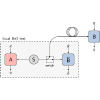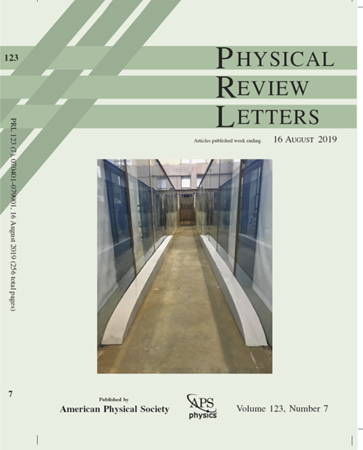与设备无关的量子密钥分发的熵限与本地贝尔测试
IF 8.1
1区 物理与天体物理
Q1 PHYSICS, MULTIDISCIPLINARY
引用次数: 0
摘要
独立于设备的量子密钥分发(DIQKD)的主要挑战之一是在长距离上实现所需的贝尔违规,因为信道损耗会导致整体检测效率低下。最近的研究探索了通过使用本地贝尔测试来认证长距离非本地相关性的概念。在这里,一个额外的量子设备被放置在靠近一方的位置,利用短距离相关性来验证长距离的非局域行为。然而,现有的研究要么没有解决 DIQKD 在这种设置下针对主动攻击者的安全性问题,要么使用的方法不能对密钥速率产生严格的约束。在这项工作中,我们介绍了在这种情况下密钥率计算任务的一般表述,它可以与最近开发的分析标准 DIQKD 的方法相结合。利用这种方法,我们证明了如果短距离设备表现出足够高的检测效率,那么与标准 DIQKD 设置相比,在检测效率较低的长距离分支中也能实现正密钥率。这凸显了在利用短距离相关性验证量子相关性的情况下,DIQKD 在长距离上提高性能的潜力。本文章由计算机程序翻译,如有差异,请以英文原文为准。

Entropy Bounds for Device-Independent Quantum Key Distribution with Local Bell Test
One of the main challenges in device-independent quantum key distribution (DIQKD) is achieving the required Bell violation over long distances, as the channel losses result in low overall detection efficiencies. Recent works have explored the concept of certifying nonlocal correlations over extended distances through the use of a local Bell test. Here, an additional quantum device is placed in close proximity to one party, using short-distance correlations to verify nonlocal behavior at long distances. However, existing works have either not resolved the question of DIQKD security against active attackers in this setup, or used methods that do not yield tight bounds on the key rates. In this work, we introduce a general formulation of the key rate computation task in this setup that can be combined with recently developed methods for analyzing standard DIQKD. Using this method, we show that if the short-distance devices exhibit sufficiently high detection efficiencies, positive key rates can be achieved in the long-distance branch with lower detection efficiencies as compared to standard DIQKD setups. This highlights the potential for improved performance of DIQKD over extended distances in scenarios where short-distance correlations are leveraged to validate quantum correlations.
求助全文
通过发布文献求助,成功后即可免费获取论文全文。
去求助
来源期刊

Physical review letters
物理-物理:综合
CiteScore
16.50
自引率
7.00%
发文量
2673
审稿时长
2.2 months
期刊介绍:
Physical review letters(PRL)covers the full range of applied, fundamental, and interdisciplinary physics research topics:
General physics, including statistical and quantum mechanics and quantum information
Gravitation, astrophysics, and cosmology
Elementary particles and fields
Nuclear physics
Atomic, molecular, and optical physics
Nonlinear dynamics, fluid dynamics, and classical optics
Plasma and beam physics
Condensed matter and materials physics
Polymers, soft matter, biological, climate and interdisciplinary physics, including networks
 求助内容:
求助内容: 应助结果提醒方式:
应助结果提醒方式:


